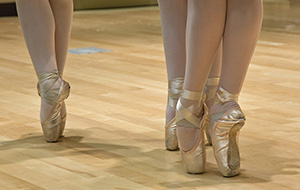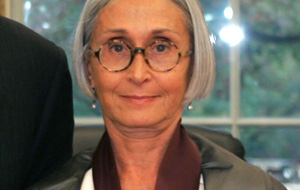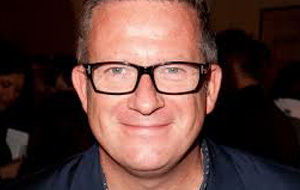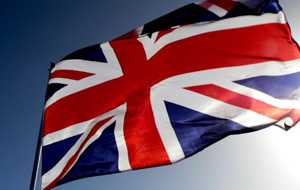 The aesthetics of ballet are continuing to evolve, however something which has remained a constant is the appearance of the foot when it is fully pointed. The ankle joint has limited movement outwards and inwards, however the adjustments of the foot’s position can make a big difference to how it looks to the audience.
The aesthetics of ballet are continuing to evolve, however something which has remained a constant is the appearance of the foot when it is fully pointed. The ankle joint has limited movement outwards and inwards, however the adjustments of the foot’s position can make a big difference to how it looks to the audience.
The foot as an extension of the ankle can elongate an arabesque or alternatively turn it inwards and demonstrate a weaker foot by sickling. When the foot is pointed in a neutral position an invisible line can be traced up through the floor, foot and into the ankle. Whilst this is technically correct, a winged shape can be seen as more desirable in that the toes are pointed outwards, extending the line. Sickling the foot might indicate poor training or weakness in the ankle, as well as demonstrating a more unsightly line.
The ankle has a slightly larger range of motion inwards, so students may be prone to sickling regardless. Genetics or anatomy can also contribute to a student’s tendency to sickle, and injuries can occur when the foot is both sickled and weight-bearing. This pulls the tendons of the ankle out of alignment, yet injury can occur when winging the foot too. Sickling can even be the intention for some choreographers, if that is what the movement or piece demands, yet for the majority of times, improving ankle strength and stability will minimise sickling.
If the foot winging is supporting weight, this too pulls the ankle joint out of alignment. Dancers may force their heels forward with tendus, instead of using their turnout. This places stress on the tendons on the inside of the foot and twists the knee joints. Despite this, winging could be encouraged in non-weight bearing positions in order to improve individual aesthetics and enhance the line – and limited turn out – the dancer is creating. Turn out must be fully engaged however, so as not to solely rely on the shape of the foot.

 There are many dance-inspired fitness methods on the market today, from fitness trainers who used to be dancers to those who use dance as a means to remaining happy and healthy, whilst not having a dance background. Aerobics and Zumba classes still have their place, but these are now two of many different options for class participants. Workouts of these kind offer a combination of dance, fitness and wellbeing, and there is truly something to suit everyone, be it at sports centres or the local dance studio.
There are many dance-inspired fitness methods on the market today, from fitness trainers who used to be dancers to those who use dance as a means to remaining happy and healthy, whilst not having a dance background. Aerobics and Zumba classes still have their place, but these are now two of many different options for class participants. Workouts of these kind offer a combination of dance, fitness and wellbeing, and there is truly something to suit everyone, be it at sports centres or the local dance studio. Twyla Tharp Dance recently took the premiere of its choreographer’s latest creation to Italy, performed at the end of June when the company visited Florence, Ravenna and Rome. This Italian tour saw the preview of a new work as well as two works performed from Tharp’s repertory. She has been creating dance for 50 years, and during that time she has choreographed over 160 works. These include 129 dances, 12 television specials, six Hollywood films, four full-length ballets, four Broadway shows and two figure skating routines.
Twyla Tharp Dance recently took the premiere of its choreographer’s latest creation to Italy, performed at the end of June when the company visited Florence, Ravenna and Rome. This Italian tour saw the preview of a new work as well as two works performed from Tharp’s repertory. She has been creating dance for 50 years, and during that time she has choreographed over 160 works. These include 129 dances, 12 television specials, six Hollywood films, four full-length ballets, four Broadway shows and two figure skating routines. The 15th Annual World Hip Hop Championship is set to hit Las Vegas in August, where the world’s top hip hop and street dancers will be competing at the 2016 World Hip Hop DANCE Championship and World Battles. Otherwise referred to as “the Olympics of hip hop dance”, it will see a record number of 3,500 dancers representing 50 countries compete.
The 15th Annual World Hip Hop Championship is set to hit Las Vegas in August, where the world’s top hip hop and street dancers will be competing at the 2016 World Hip Hop DANCE Championship and World Battles. Otherwise referred to as “the Olympics of hip hop dance”, it will see a record number of 3,500 dancers representing 50 countries compete. At the end of June, former ballerina Darcey Bussell CBE, in her capacity as President of the Royal Academy of Dance, escorted Sir Matthew Bourne to Buckingham Palace for a special occasion. In this exciting event as the Patron of the Royal Academy of Dance, Her Majesty The Queen presented the recently-knighted Sir Matthew Bourne with the Academy’s Queen Elizabeth II Coronation (QEII) Award, internationally renowned as one of the most coveted honours in dance. Bourne has contributed above and beyond to the dance industry, introducing new audiences and dancers to his world of performing.
At the end of June, former ballerina Darcey Bussell CBE, in her capacity as President of the Royal Academy of Dance, escorted Sir Matthew Bourne to Buckingham Palace for a special occasion. In this exciting event as the Patron of the Royal Academy of Dance, Her Majesty The Queen presented the recently-knighted Sir Matthew Bourne with the Academy’s Queen Elizabeth II Coronation (QEII) Award, internationally renowned as one of the most coveted honours in dance. Bourne has contributed above and beyond to the dance industry, introducing new audiences and dancers to his world of performing. With the news of the UK’s exit from the European Union still reverberating, there has been lots to take in since the announcement of the referendum result on 24 June. Voting remain or leave have many different viewpoints attached, however in terms of the arts it is clear that the UK would have benefitted from remaining in the European Union.
With the news of the UK’s exit from the European Union still reverberating, there has been lots to take in since the announcement of the referendum result on 24 June. Voting remain or leave have many different viewpoints attached, however in terms of the arts it is clear that the UK would have benefitted from remaining in the European Union.